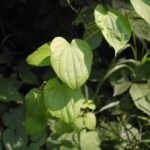| Common Name: |
Wild Yam |
| Other Names: |
China Root, Colic Root, Mexican Wild Yam, Rheumatism Root, Wild Yam Root, Yuma |
| Botanical Name: |
Dioscorea villosa |
| Genus: |
Dioscorea |
| Family: |
Dioscoreaceae |
| Native Location: |
N America |
| Cultivation: |
Rich, well-drained soil in sun or partial shade. Tubers may rot in cool, damp conditions when dormant. |
| Propagation: |
By seed sown in spring at 19-24°C (66-75°F); by division or sections of tubers in autumn or early spring; by bulbils planted in spring. |
| Harvest: |
Tubers, roots, and rhizomes are lifted in autumn. Dioscorea batatas is used raw or baked with flour or soil, according to diagnosis, and D. villosa is dried for use in liquid extracts or used fresh for homeopathic preparations. |
| Height: |
5m (15ft) |
| Hardiness: |
Z4-8 |
| Parts Used: |
Roots, rhizomes |
| Chemical Constituents: |
Dioscin
Diosgenin
Resin
Saponin
|
| Properties: |
An acrid, anti-inflammatory herb that relaxes spasms, stimulates bile flow, and dilates blood vessels. |
| Known Effect: |
Breaks membranous covering, destroying red bloods cells (toxic to fish and amoeba)
Miscellaneous Information:
Diosgenin is a steroid base used to synthesize cortisone and progesterone (hormones).
|
| Possible Additional Effects: |
May treat arthritis by allegedly removing accumulated waste in joints.
May reduce menopausal symptoms
May relieve morning sickness
May treat menstrual cramps
|
| Medicinal Uses: |
Internally for arthritis, colitis, irritable bowel syndrome, diverticulitis, gastritis (especially in alcoholics), gall bladder complaints, Crohn's disease, morning sickness, painful menstruation, ovarian and labor pains, bronchitis, excess mucus, asthma, whooping cough, and cramp. Used in homeopathy for colic (especially in babies).
To treat menstrual problems, rheumatic conditions, and gallbladder colic. |
| Possible Side Effects: |
Wild yam's side effects include menstrual changes, headache, and allergic reactions. |
| Warnings and Precautions: |
Don't take if you:
Are pregnant, think you may be pregnant, or plan pregnancy in the near future
Have any chronic disease of the gastrointestinal tract, such as stomach or duodenal ulcers, reflux esophagitis, ulcerative colitis, spastic colitis, diverticulosis, or diverticulitis
Are pregnant and want to treat morning sickness
Consult your doctor if you:
Take this herb for any medical problem that doesn't improve in 2 weeks (There may be safer, more effective treatments.)
Take any medicinal drugs or herbs including aspirin, laxatives, cold and cough remedies, antacids, vitamins, minerals, amino acids, supplements, other prescription or non-prescription drugs
Pregnancy:
Dangers outweigh any possible benefits. Don't use.
Breastfeeding:
Dangers outweigh any possible benefits. Don't use.
Infants and Children:
Treating infants and children under 2 with any herbal preparation is hazardous.
Others:
None are expected if you are beyond childhood, under 45, not pregnant, basically healthy, take it only for a short time and do not exceed manufacturer's recommended dose.
Storage:
Store in cool, dry area away from direct light, but don't freeze.
Store safely out of reach of children.
Don't store in bathroom medicine cabinet. Heat and moisture may change the action of the herb.
Safe Dosage:
Consult your doctor for the appropriate dose for your condition.
|
| Toxicity: |
Generally regarded as safe when taken in appropriate quantities for short periods of time |
| Adverse Reactions, Side Effects, or Overdose Symptoms: |
| Signs and Symptoms |
What to Do |
|
| Diarrhea |
Discontinue. Call doctor immediately. |
| Nausea or Vomiting |
Discontinue. Call doctor immediately. |
|
| Drug Interactions: |
| Taking wild yam with these drugs may increase the estrogenic effects of the drug: |
| Cyproterone and Ethinyl Estradiol, (Diane-35) |
Estradiol, (Climara, Estrace) |
Estradiol and Norethindrone, (Activella, CombiPatch) |
| Estradiol and Testosterone, (Climacteron) |
Estrogens (Conjugated A/Synthetic), (Cenestin) |
Estrogens (Conjugated/Equine), (Congest, Premarin) |
| Estrogens (Conjugated/Equine) and Medroxyprogesterone, (Premphase, Prempro) |
Estrogens (Esterified), (Estratab, Menest) |
Estrogens (Esterified) and Methyltestosterone, (Estratest, Estratest HS) |
| Estropipate, (Ogen, Ortho-Est) |
Ethinyl Estradiol, (Estinyl) |
Ethinyl Estradiol and Desogestrel, (Cyclessa, Ortho-Cept) |
| Ethinyl Estradiol and Ethynodiol Diacetate, (Demulen, Zovia) |
Ethinyl Estradiol and Etonogestrel, (NuvaRing) |
Ethinyl Estradiol and Levonorgestrel, (Alesse, Triphasil) |
| Ethinyl Estradiol and Norelgestromin, (Evra, Ortho Evra) |
Ethinyl Estradiol and Norethindrone, (Brevicon, Ortho-Novum) |
Ethinyl Estradiol and Norgestimate, (Cyclen, Ortho Tri-Cyclen) |
| Ethinyl Estradiol and Norgestrel, (Cryselle, Ovral) |
Mestranol and Norethindrone, (Necon 1/50, Ortho-Novum 1/50) |
Polyestradiol, (Polyestradiol) |
| Taking wild yam with these drugs may decrease the anti-inflammatory effect of the drug: |
| Celecoxib, (Celebrex) |
Etodolac, (Lodine, Utradol) |
Ibuprofen, (Advil, Motrin) |
Indomethacin, (Indocin, Novo-Methacin) |
| Ketoprofen, (Orudis, Rhodis) |
Ketorolac, (Acular, Toradol) |
Piroxicam, (Feldene, Nu-Pirox) |
Rofecoxib, (Vioxx) |
|
| Disease Effects: |
This herb may have estrogen-like effects and should not be used by women with estrogen sensitive breast cancer or other hormone sensitive conditions. |
| Bibliography: |
Encyclopedia of Herbs by Deni Brown Copyright © 1995, 2001 Dorling Kindersley Limited. Pp 194-195
The Essential Herb-Drug-Vitamin Interaction Guide by Geo. T. Grossberg,MD and Barry Fox,PhD Copyright©2007 Barry Fox,PhD. Pp.491-492
Vitamins, Herbs, Minerals & Supplements The Complete Guide by H. Winter Griffith, MD Copyright©1998 pp. 429-430 |

